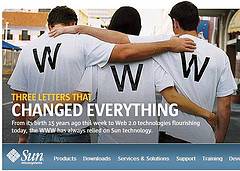To
celebrate the 15th
anniversary of the World Wide Web, today I interviewed two distinguished people from
Sun Microsystems – Tim Bray (Director of
Web Technologies) and Radia
Perlman (Distinguished Engineer). Sun of course was one of the key Web companies from
the 90’s and is still going strong today, under the leadership of Jonathan Schwartz. I discussed with Tim and
Radia the past 15 years of the Web and also looked ahead to its future. We also talked about things like P2P and its place on the Web (see below).

UPDATE: The full interview is now available as a podcast.
Both have been in the computing business a long time and have had very influential
careers. Tim Bray co-invented XML 1.0 and was
Tim Berners-Lee’s appointee on the W3C Technical Architecture Group in 2002-2004 –
amongst other accomplishments. Radia Perlman, who has a PhD from MIT in computer science,
specializes in network and security protocols. In 1983 (according to a Sun timeline of the
Web) she invented the spanning tree algorithm and is also sometimes referred to as the “Mother of the
Internet”. So these are two incredibly smart Web technologists – and to be honest I was a
bit nervous about speaking to them! Note that this interview will be published across 2 posts.
Aha moment on the Web?
I started out by asking when Tim and Radia first got interested in the Web – was there
an ‘aha’ moment?
Tim said
that in the early 90’s he was working for a company called Open Text Systems, which was
at that point a vendor of full-text search software. He had noticed the Web around that
time and played around with early browsers. Then in early ’94 he was at a conference and
one of the speakers said that search was going to be a big application on the Web. “It
was so painfully obvious,” Tim said, “that this was a good combination to work on – that
I was hooked. So I’ve basically been earning my living worrying about the Web and working
with the Web ever since then.”

For Radia it was more a gradual process over the years. She mentioned using email and
transferring files across networks in the pre-Web days – “you could do the equivalent of
Instant Messenger back then”.
The good and the bad of the Web
The Web
has always had two sides for Radia. “At all stages I’ve been excited and enthralled by
the positive opportunities [of the Web]”, she told me, “but I’m terrified by the
downsides.” She mentions robustness as one example – “if the Internet is broken, then the
way that you fix it is using the Internet to send network management messages. That is
just so scary.” So part of her early work on the Internet has been to make it so that it
doesn’t get into the same kind of bad state that a PC gets into – “you can’t reboot the
Internet”.

Radia is concerned about society getting more and more dependent on the Internet
– she says it’s exciting, but the security implications are scary. She’s also concerned
about libraries getting replaced by the Internet and correctness of information on the
Net (e.g. with scientific information).
Sun’s history on the Web – servers and Java
I then asked about Sun’s history on the Web – and put my foot in it when I suggested
that Java has been Sun Microsystems’ main contribution to the Web. Tim said that “steel
boxes with CPUs and memory inside them have been the largest contribution” by Sun. He
said that since the mid-90’s Sun has primarily been in the server business. In particular
their expertise in servers that can handle heavy loads and stay up for a long time,
proved to be a good match for the Web. So Tim thinks that Sun’s role as a systems vendor,
from the hardware to middleware, has been where they’ve had the most impact.
Radia
agreed and said that “it’s the servers that really were the heart of all the huge,
scalable web sites – and at reasonably low cost”. Tim said that Sun was the first vendor
to commit to shipping servers with “no proprietary networks – they were TCP/IP and that’s
all they were”. So this meant they were interoperable and “Sun servers have been all over
the Web” as a result. Tim said there’s a lesson to be gained from that – which is that “a
rising tide floats all boats.” He said “the right way to do the good thing for the Web
and the good thing for Sun is to play by the rules – be a good citizen.”

He pointed out that even today there are companies that try to “get a little
proprietary edge in there and set up a toll booth – but that’s not the way to make real
money on the Web”. He says playing by the rules and being a good citizen is the best
way.
I asked what are some examples of big websites that have used Sun servers. Tim said
that “eBay has always been a Sun site”.
P2P and the Web
I then moved the subject over to P2P technologies and mentioned the post I did last
week about
Skyrider, a new peer-to-peer platform that aims to commercialize P2P. I wanted to
know if Tim and Radia see P2P as coming more into play on the Web, as large media files
get shuffled around. Will Sun be involved in this kind of thing?
Tim starts off by saying that P2P has been “a tough sell […] harder than it should
be given the Internet’s architecture.” But even so he doesn’t see P2P as being a central
growth factor for the Web:
“I think, Richard, that the name of your blog [read/writeweb] is the key thing – the
thing that has been interesting and new and driving the whole ecosystem over the last 2-3
years has been the fact that everybody’s been piling on board. That it’s becoming a
writeable medium, not just a readable medium.”
Radia is also not a big fan of peer to peer when it comes to the Web, but she notes there are different
interpretations of what P2P is. “Peer-to-peer as primarily geared to being able to trade
copyrighted information […] is the reason why people want to do it.” She says that from
a technical point of view, it’s much better to have central sites where you co-ordinate
and certify people. She thinks that doing it in a pure P2P way (i.e. decentralized) “makes security and scalability very
difficult”. Her ideal is having central sites where you
rendezvous, so you know what is where. And then the file goes peer to peer from that point.
Tim
said though that BitTorrent is “remarkably clever” and Sun used BitTorrent when they open
sourced Solaris. He said that BitTorrent is “a better way to distribute very large
volumes of data around the Internet” – and given that BitTorrent “doesn’t allow you to
anonymize yourself, it is less prone to piratical abuse”. But he stands by his claim that
it’s not the big data files, but people that are making the difference on the Web
right now.

But does P2P have a bright future?
Perhaps showing my technical naivety, I pursued the question of whether P2P will be
used more over time in media and business – a la Skype today. Tim then asked Radia to
give me an overview of “why true peer to peer is hard to build in a world of NATs” [ed: not “Nets” as I originally wrote]. Radia
said that true peer to peer means that everyone can be anonymous. But she says having
central sites where people can register is key to making the Web scalable. Also
Radia is concerned by the security aspects of ‘true’ P2P – e.g. people could send
damaging files around. So that’s why both Radia and Tim are skeptical of my notion that
P2P will drive more and more activity on the Web going forward.
That ends Part 1 of my interview with Tim Bray and Radia Perlman of Sun Microsystems.
Part 2 will feature discussions around Web-connected devices, Web Office, how Sun fits
into ‘web 2.0’, and I pick Tim’s brain about ATOM (an alternative RSS format that Tim
helps drive) and GData.
UPDATE: The full interview is now available as a podcast.










